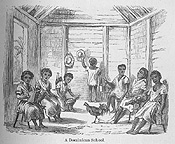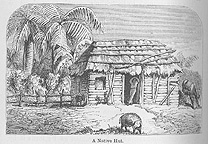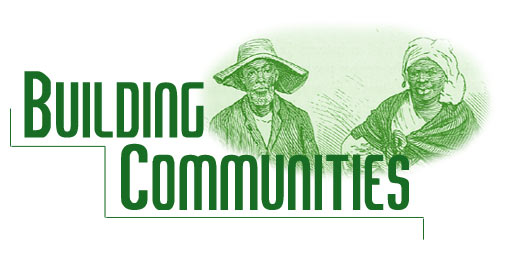
In order to understand the evolution of education on Barbados for the ex-slaves, one must first
understand a little bit of how the slaves were eventually freed. The
island of Barbados was under British rule until November
30, 1966.
In 1834, the British government decided to begin to free the slaves
through apprenticeship. The British decided that on this island, unlike
in Antigua, they would try apprenticeship before
the total emancipation of the slaves to see if this system of more
gradual change worked better. Apprenticeship was a form of wage labor
because ex-slaves were paid for their work, but it was not completely
free because they were obligated to work for a specified set of hours
and for a specified person. Although this situation was better than
total slavery, it still was not total freedom. Still, once apprenticeship
began, education on the island began to flourish. During apprenticeship,
and after emancipation finally became a reality, education was a priority
for ex-slaves. Through the development of education, working conditions
and family life were also redefined.
As
apprentices, ex-slaves were not allowed to bear arms or hold any civil
office of importance.
[1]
Apprentices were also obligated to work forty-five
hours a week and had to work for the person who was once their master.
They were not allowed to compete for better wages or more favorable
working conditions. Along with these denials of rights, ex-slaves
also received a few limited rights. “No apprenticed laborer can be
taken from the island and no praedial apprentice
can be removed from his estate without the consent of one or more
of the special justices.” Praedial laborers were slaves who worked in the fields, mainly
involved in agriculture and cultivation. Non-Praedial
laborers were mostly domestic slaves who worked in the home. In any
event, no consent could be given if the move would break up a family
or have a negative impact on the health or welfare of the apprentice.
[2]
Sylvester Hovey,
an observer who came to Barbados from the United States in 1838, argued that the reason that
apprenticeship worked better in Barbados than in Jamaica was that both the whites and blacks
of the first island were more prepared for change. The people’s preparedness
came from talks at government meetings, gossip among the slaves about
apprenticeship and then their eventual freedom, and from English visitors. This acceptance of change does not mean that
things always ran smoothly, but overall both the ex-masters and ex-slaves
were more receptive to each other than they were on other islands
where apprenticeship was also being utilized. On the island of Barbados, the apprenticeship of non-praedial laborers ended on August 1st,
1838
and the apprenticeship of praedial workers
ended on August
1st, 1840.
[3]
During
apprenticeship and through the end of slavery, family life also changed
and became less helter-skelter. While in the apprenticeship stage
in Barbados, a chaplain noticed that, “the married people on the estate conduct themselves
more soberly and chastely, and more rare indeed is the instance of
a couple going to live with each other without being lawfully married.”
[4]
With the growing freedom of the ex-slaves’ lives
also came the freedom to form unified families. A white native in
Barbadian told Hovey that “family relations
are becoming more sacred; mothers are more fond of their children;
and it is believed that the number of births is greater, and the number
of deaths among children considerably less than it was during slavery.”
[5]
Children were living longer, mothers felt they
could better bond with their children because there was not the great
fear that they would die at such an early age or that they would be
sold away.
noticed that, “the married people on the estate conduct themselves
more soberly and chastely, and more rare indeed is the instance of
a couple going to live with each other without being lawfully married.”
[4]
With the growing freedom of the ex-slaves’ lives
also came the freedom to form unified families. A white native in
Barbadian told Hovey that “family relations
are becoming more sacred; mothers are more fond of their children;
and it is believed that the number of births is greater, and the number
of deaths among children considerably less than it was during slavery.”
[5]
Children were living longer, mothers felt they
could better bond with their children because there was not the great
fear that they would die at such an early age or that they would be
sold away.
After
emancipation in Barbados, Special Magistrates, appointed bythe Birtish government to mediate
between ex-owners and ex-slaves, reported monthly on the changing
conditions in their provinces. They
were supposed to keep six basic elements in mind: habits of the peasantry;
their tastes; the rate of mortality; the nature of criminal offenses;
civil offenses; and the relationship between the newly freed apprentices
and the slaveholders. The white officials back in England wanted to know if the freed slaves
were developing neighborhoods and villages. All new institutions were
a sign of growing prosperity and interest in the economy. They were
also interested in any new inventions to make work and life easier
and the labor supply.
[6]
During apprenticeship, these writings went back
and forth “by means of two lines of packets from England to Barbadoes…a
communication twice a month was maintained between England and all her West India colonies.”
[7]
Along
with the monthly reports on labor went requests from the citizens
of Barbados and the newly freed slaves. In a
letter to the Governor of Barbados, Sir Evan J. Murray Macgreggor,
Baronet of England, the newly freed slaves asked for help with the
education of their children and adults in order “to afford an equal
opportunity (to the newly freed slaves) in competing for places (employment).”
[8]
It was  important
to these newly freed people to educate themselves and their children.
“In 1825 there was but one public school in the island for the instruction
of slaves…the number connected with the church in 1834, for the instruction
of the poor including apprentices was 155.”
[9]
These schools were taught by members of the church
the school was connected with and usually by another person of African
descent. “The school was taught by an African of pure blood, who filled
his place apparently with as much ability as any gentleman I ever
saw in the same situation.”
[10] important
to these newly freed people to educate themselves and their children.
“In 1825 there was but one public school in the island for the instruction
of slaves…the number connected with the church in 1834, for the instruction
of the poor including apprentices was 155.”
[9]
These schools were taught by members of the church
the school was connected with and usually by another person of African
descent. “The school was taught by an African of pure blood, who filled
his place apparently with as much ability as any gentleman I ever
saw in the same situation.”
[10]
When
comparing Antigua, where emancipation was granted immediately, to
Barbados, Sylvester Hovey was quick to point
out that in Barbados, “education is by no means common among them
as it is in the same class in Antigua…they have much less moral principle,
but in the use of language and general intelligence, they are full
their equals.” Since skin tone was such an important factor on both
Barbados and the other islands, one which often determined social
status, Hovey also noted color’s role (or
lack thereof) in education. “Though the children (in school) took
their places at the recitations, according to their answers, I did
not perceive that their rank in the class corresponded at all to the
shades of their skin.” In line with the prejudices at the time, even
sympathetic whites like Hovey initially
assumed that darker-skinned people were more ignorant and idle. In
many cases, despite his observation, the lighter the skin, the more
opportunities a person of African or partially African descent was
offered in education, job placement and positions for public office.
[11]
It was also apparent to Hovey
that although there were separate schools for girls and boys, the
appearance of the boy’s school was superior to that of the girls.
Through the end of apprenticeship and the beginning of emancipation,
the focus of education turned to a select few on the island.
While
the British and white Barbadians did not cast the net of education
equally over the whole population, some officials soon realized that
within their limited sample of the populace they were finding students
with tremendous intelligence and talent, who merited a more extensive
and polished education. In a letter to Lord John Russel,
Governor Sir E. J. Murray Macgregor wrote he has “exhorted the most
intelligent, as they cannot afford to instruct their children individually,
to act in concert…in order to effect by subscribing for the education
in England, of some of these youths, who indicate talent.”
[12]
Of course, this would be accompanied by an exorbitant
cost. In order to offset this cost, both the parents of the children
and the local officials devised a plan to finance their education.
He went on to say:
I am thereby induced to submit to your Lordship, the expediency
of devoting a portion of the National Funds destined to the forming
of schools, to the purpose of defraying the expense of supporting
a certain number of young persons of color, while residing in Britain,
in attendance in our public seminaries; as well as the cost of their
voyages from the West Indian colonies.
[13]
Macgregor’s
was not the only plan devised. Another plan devised by the people
of color on the island was to raise funds by voluntary contributions.
[14]
These funds would be collected in order to help
their children “obtain opportunities of acquiring a knowledge of the
world, rarely to be obtained in these small settlements, and of contracting
friendships…with powerful individuals whose protection would encourage
and support them in their future career abroad.”
[15]
These letters, which were written to England, document the emphasis the freed
slaves were putting on the education of both their children and their
people.
However,
by taking money out of the National Fund, this plan in essence took
money away from other children who also warranted and merited a good
education. Others also realized that by asking for donations, those
who sought to raise funds to educate a select few abroad were asking
for money from people who barely had enough  money
to eat and clothe themselves. An ex-slave realized this defect and
wrote to England: “But we fear, from the deficiency
of our hereditary possessions, and from the general limited resources
of the colored population…it will be next to impossible, of themselves
at this period, without the benevolent interposition of the parent
State, to carry out this desirable project.”
[16]
So, even though plans were devised by both the
ex-slaves and the white officials on the island to attain money from
both the National Fund for the building of schools and from the colored
people on the island individually, they knew nothing could really
be done without help from England. money
to eat and clothe themselves. An ex-slave realized this defect and
wrote to England: “But we fear, from the deficiency
of our hereditary possessions, and from the general limited resources
of the colored population…it will be next to impossible, of themselves
at this period, without the benevolent interposition of the parent
State, to carry out this desirable project.”
[16]
So, even though plans were devised by both the
ex-slaves and the white officials on the island to attain money from
both the National Fund for the building of schools and from the colored
people on the island individually, they knew nothing could really
be done without help from England.
Apprenticeship
and emancipation was a great time of change in Barbados. Work, family life and education
were all being reinvented and redefined for newly freed slaves. The will to form schools and educate themselves
after years of oppression and being left in the dark demonstrates
the willingness of these people to transform their own lives, to get
ahead in the world, and to start doing so immediately. Through education
this newly freed people saw a way to advance in the world and they
were going to take full advantage of all opportunities available to
them.
Works Cited
Hovey, Sylvester. Letters from the West
Indies: Relating especially to the Danish island St. Croix, and to
the British Islands Antigua, Barbadoes,
and Jamaica. New York: Gould and Newman, 1838.
Parliament. Papers Relative to
the West
Indies.
1840-42 Jamaica-Barbados. London: W. Clowes and Sons, 1842.
[1]
Sylvester Hovey, Letters
from the West Indies: Relating
especially to the Danish island St. Croix,
and to the British
Islands
Antigua, Barbadoes, and Jamaica,
(New York, 1838), 39, 96-116.
[2]
Hovey, Letters from the West
Indies
[3]
Hovey, Letters from the West
Indies
[7]
Parliament, Papers Relative to the West
Indies. 1840-42 Jamaica-Barbados,
58-61.
[8]
Papers Relative to the West
Indies. 1840-42 Jamaica-Barbados, 58-61.
[9]
Hovey, Letters, 96-106.
[10] Hovey, Letters, 96-106.
[11]
See Kiara Bell’s paper in this section
[12]
Hovey, Letters, 96-116.
[13]
Papers Relative to the West
Indies. 1840-42 Jamaica-Barbados, 58-61.
[14]
Papers Relative to the West
Indies. 1840-42 Jamaica-Barbados, 58-61.
[15]
Papers Relative to the West
Indies. 1840-42 Jamaica-Barbados, 58-61.
[16]
Papers Relative to the West
Indies. 1840-42 Jamaica-Barbados, 58-61.
|

